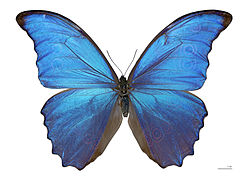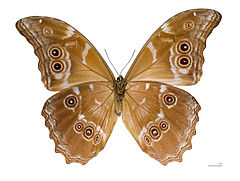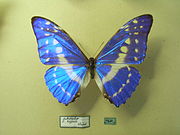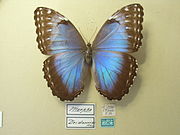- Morpho
-
 Pour les articles homonymes, voir Morpho (homonymie).
Pour les articles homonymes, voir Morpho (homonymie). Morpho
Morpho
Morpho didius - Muséum de Toulouse Classification Règne Animalia Embranchement Arthropoda Classe Insecta Ordre Lepidoptera Famille Nymphalidae Sous-famille Morphinae Genre Morpho
Fabricius, 1807
D'autres documents multimédia
sont disponibles sur Commons Retrouvez ce taxon sur Wikispecies
Retrouvez ce taxon sur Wikispecies Morpho didius- Muséum de Toulouse
Morpho didius- Muséum de Toulouse
Morpho est un genre de papillons, de la famille des Nymphalidae et de la sous-famille des Morphinae.
Le nom vernaculaire morpho ou morpho bleu peut désigner plusieurs espèces de papillons bleu iridescent du genre Morpho, qui vivent dans les forêts tropicales d'Amérique centrale et d'Amérique du Sud : Brésil, Costa Rica, Équateur, Guyane (Surinam, Guyana et Guyane), et Venezuela. Ce papillon étonne par les couleurs métalliques de ses ailes. Le revers plus discret est doté d'ocelles, qui imitent les yeux de plusieurs oiseaux, destinés à effrayer les prédateurs. La chenille, quant à elle, dégage une odeur assez repoussante. Il peut vivre jusqu'à deux mois, et se nourrit principalement de jus de fruits mûrs. Il survole les cours d'eau où il a la place de voler librement et où il évite un maximum les prédateurs. C'est l'un des plus grands papillons existants avec 12 à 20 cm d'envergure.
Historique et dénomination
- Le genre a été nommé Morpho par Johan Christian Fabricius en 1807.
- L'espèce type est : Papilio achilles (Linnaeus, 1758)
Synonymie
- Balachowskyna (Le Moult & Réal, 1962)
- Brassolis (Illiger, 1807)
- Cypritis (Le Moult & Réal, 1962)
- Cytheritis (Le Moult & Réal, 1962)
- Grasseia (Le Moult & Réal, 1962)
- Heliornis (Billberg, 1820)
- Iphimedeia (Fruhstorfer, 1913)
- Iphixibia (Le Moult & Réal, 1962)
- Leonte (Hübner, 1819)
- Megamede (Hübner, 1819)
- Pessonia (Le Moult & Réal, 1962)
- Potamis (Hübner, 1807).
- Schwartzia (Blandin, 1988)
- Zeuxidion (Le Moult & Réal, 1962)
Taxinomie
Il existe neuf sous-genres[1].
Sous-genre Balakowskiana
- Morpho aurora (Westwood, 1847)
Sous-genre Cypritis (Le Moult & Réal 1962)
- Morpho aphrodite (Le Moult & Real)
- Morpho cacica (Staudinger)
- Morpho diana (Dixey)
- Morpho helena (Staudinge)
- Morpho cypris (Westwood, 1851)
- Morpho rhetenor (Cramer, 1775)
Sous-genre Cytheritis (Le Moult & Réal 1962)
- Morpho aega (Hübner, 1822)
- Morpho adonis (Cramer, 1775)
- Morpho eros (Staudinger)
- Morpho eugenia (Deyrolle, 1860)
- Morpho marcus (Schaller)
- Morpho nymphalis (Le Moult & Real)
- Morpho lympharis (Butler)
- Morpho ockendeni (Rothschild )
- Morpho portis (Godman & Salvin)
- Morpho rhodopteron (Godman & Salvin)
- Morpho schultzei (Le Moult & Real)
- Morpho sulkowskyi (Esper, 1777)
- Morpho stoffeli (Le Moult & Real)
- Morpho thamyris (Felder)
- Morpho uraneis (Bates)
- Morpho zephyritis (Felder)
Sous-genre Grasseia (Le Moult & Réal 1962)
- Morpho amathonte (Deyrolle, 1860)
- Morpho centralis (Staudinger)
- Morpho menelaus (Linnaeus, 1758)
- Morpho occidentalis (Felderman)
- Morpho mattogrossensis (Talbot)
- Morpho nestira (Hübner)
- Morpho melacheilus (Staudinger)
- Morpho didius (Hopffer, 1874)
- Morpho godarti (Güérin de Ménéville, 1829)
Sous-genre Iphimedeia
- Morpho amphitrion (Staudinger, 1887)
- Morpho cisseis (C. & R. Felder, 1860)
- Morpho hercules (Dalman, 1823)
- Morpho hecuba (Linnaeus, 1771)
- Morpho justitiae (Godman)
- Morpho phanodemus Hew.
- Morpho niepelti
- Morpho richardus (Fruhstorfer)
- Morpho telemachus (Linnaeus, 1758)
- Morpho theseus (C. & R. Felder, 1862)
- Morpho werneri Hopffer
Sous-genre Iphixibia (Le Moult & Réal 1962)
- Morpho anaxibia (Esper, 1777)
Sous-genre Morpho (Fabricius, 1807)
- Morpho achillaena (Hübner, 1822)
- Morpho achilles (Linnaeus, 1758)
- Morpho briseis (Felder)
- Morpho coelestis (Butler)
- Morpho confusa (Le Moult & Real)
- Morpho corydon (Guen)
- Morpho deidamia (Hübner, 1816)
- Morpho electra (Röber)
- Morpho granadensis (Felder)
- Morpho guaraunos (Le Moult)
- Morpho helenor (Cramer, 1776)
- Morpho hermione (Röber)
- Morpho hyacinthus (Butler)
- Morpho leontius (Felder)
- Morpho lycanor (Fruhstorfer)
- Morpho marinita (Butler)
- Morpho micropthalmus (Fruhstorfer)
- Morpho montezuma (Guen)
- Morpho neopltolemus (Wood)
- Morpho octavia (Bates)
- Morpho papallela (Le Moult)
- Morpho papirius (Hopffer)
- Morpho patroclus (Felder)
- Morpho peleides (Kollar, 1850)
- Morpho peleus (Röber)
- Morpho pseudagamedes (Weber)
- Morpho rugitaeniata (Fruhstorfer)
- Morpho taboga (Le Moult & Real)
- Morpho telamon (Röber)
- Morpho tobagoensis (Sheldon)
- Morpho trojana (Röber)
- Morpho vitrea (Butler)
Sous-genre Pessonia (Le Moult & Réal 1962)
- Morpho catenarius (Perry, 1811)
- Morpho laertes (Drury, 1770)
- Morpho luna (Butler)
- Morpho polyphemus (Dixey)
- Morpho titei (Drury, 1770)
Notes et références
- Blandin, Patrick, 1993: The genus Morpho Lepidoptera Nymphalidae. Part 2: the subgenera Iphixibia, Cytheritis, Balachowskyna and Cypritis. Sciences Nat: Compiègne, France. 56 pages. (ISBN 0285724657 et 9780285724655)
- funet
Annexes
Articles connexes
Liens externes
Bibliographie
- Blandin, P. 2007. The Systematics of the Genus Morpho, Lepidoptera Nymphalidae Hillside Books, Canterbury.[1]
- Blandin, P. 1988. The genus Morpho, Lepidoptera Nymphalidae. Part 1. The subgenera Iphimedeia and Schwartzia. Sciences Nat, Venette.
- Blandin, P. 1993. The genus Morpho, Lepidoptera Nymphalidae. Part 2. The subgenera Iphixibia, Cytheritis, Balachowskyna, and Cypritis. Sciences Nat, Venette.
- Blandin, P. 2007. The genus Morpho, Lepidoptera Nymphalidae. Part 3. The Subgenera Pessonia, Grasseia and Morpho and Addenda to Parts 1 & 2. Hillside Books, Canterbury.[2]
Catégories :- Nymphalidé
- Lépidoptère (nom scientifique)
- Faune tropicale
Wikimedia Foundation. 2010.



